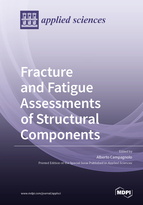Fracture and Fatigue Assessments of Structural Components
A special issue of Applied Sciences (ISSN 2076-3417). This special issue belongs to the section "Mechanical Engineering".
Deadline for manuscript submissions: closed (31 March 2020) | Viewed by 33837
Special Issue Editor
Interests: fatigue of metals; fracture mechanics; solid mechanics; structural integrity; welded joints
Special Issues, Collections and Topics in MDPI journals
Special Issue Information
Dear Colleagues,
Dealing with fracture and fatigue assessments of structural components, different approaches have been proposed in the literature. They are usually divided into three subgroups: Stress-based, strain-based and energy-based criteria.
The aim of this Special Issue is to provide an update to the state-of-the-art on these approaches. The topics which deserve particular interest for this Special Issue are: Applications to new advanced materials, such as additive materials; applications to complex and real structures; recent advanced criteria for fracture and fatigue predictions under complex loading conditions, such as multiaxial constant amplitude and random fatigue loadings.
Dr. Alberto Campagnolo
Guest Editor
Manuscript Submission Information
Manuscripts should be submitted online at www.mdpi.com by registering and logging in to this website. Once you are registered, click here to go to the submission form. Manuscripts can be submitted until the deadline. All submissions that pass pre-check are peer-reviewed. Accepted papers will be published continuously in the journal (as soon as accepted) and will be listed together on the special issue website. Research articles, review articles as well as short communications are invited. For planned papers, a title and short abstract (about 100 words) can be sent to the Editorial Office for announcement on this website.
Submitted manuscripts should not have been published previously, nor be under consideration for publication elsewhere (except conference proceedings papers). All manuscripts are thoroughly refereed through a single-blind peer-review process. A guide for authors and other relevant information for submission of manuscripts is available on the Instructions for Authors page. Applied Sciences is an international peer-reviewed open access semimonthly journal published by MDPI.
Please visit the Instructions for Authors page before submitting a manuscript. The Article Processing Charge (APC) for publication in this open access journal is 2400 CHF (Swiss Francs). Submitted papers should be well formatted and use good English. Authors may use MDPI's English editing service prior to publication or during author revisions.
Keywords
- Fracture assessment
- Fatigue assessment
- Crack
- Notch
- Etc.






